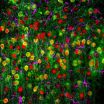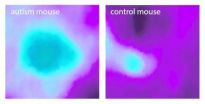(Press-News.org) Researchers at the University of California, San Diego School of Medicine have evidence suggesting that neurons in the developing brains of mice are guided by a simple but elegant birth order rule that allows them to find and form their proper connections.
The study is published online July 31 in Cell Reports.
"Nothing about brain wiring is haphazard," said senior author Andrew Huberman, PhD, assistant professor in the Department of Neurosciences, Division of Biological Sciences and Department of Ophthalmology, UC San Diego.
A mature, healthy brain has billions of precisely interconnected neurons. Yet the brain starts with just one neuron that divides and divides – up to 250,000 new neurons per minute at times during early development. The question for biologists has been how do these neurons decide which other neurons to connect to, a process neuroscientists call target selection.
The answer has both fundamental scientific value and clinical relevance. Some researchers believe that autism and other disorders linked to brain development may be caused, in part, by a failure of neurons to properly reposition their axons as needed when mistakes in target selection occur.
To better understand how a young brain gets wired, researchers focused on the development of retinal ganglion cells (RGCs) in mice. These cells connect the eyes and brain. Specifically, the main cell bodies of RGCs reside in the retina but their axons – slender projections along which electrical impulses travel – extend into the centers of the brain that process visual information and give rise to what we commonly think of as "sight," as well as other light-influenced physiological processes, such as the effect of light on mood.
For the study, scientists tagged RGCs and watched where they directed their axons during development. The experiments revealed that specific types of RGCs target specific areas of the brain, allowing mice to do things such as sense direction of motion, move their eyes and detect changes in daily light cycles. It was also observed that some types of RGCs (such as those that detect brightness and control pupil constriction) are created early in development while others (such as those controlling eye movements) are created later.
The study's main finding is that early RGCs (those created early in the sequence of brain division) make a lot of connections to other neurons and a lot of mistakes, which they then correct by repositioning or removing their axons. By contrast, later RGCs were observed to be highly accurate in their target selection skills and made almost no errors.
"The neurons are paying attention to when they were born and reading out which choices they should make based on their birthdate," said Jessica Osterhout, a doctoral student in biology and the study's lead author. "It seems to all boil down to birthdate."
The idea that timing is important for cell differentiation is a classic principle of developmental biology, but this study is among the first to show that the timing of neuronal generation is linked to how neurons achieve specific brain wiring.
In addition to clarifying normal brain development, researchers plan to examine the role of time-dependent wiring mishaps in models of human disorders, such as autism and schizophrenia, as well as diseases specific to the visual system, such as congenital blindness.
"We want to know if in diseases such as autism neurons are made out of order and as a result get confused about which connections to make," Huberman said.
INFORMATION:
Co-authors include Rana El-Danaf and Phong Nguyen, both at UC San Diego.
Funding for the study was provided, in part, by the National Institutes of Health's National Eye Institute (grant R01-EY022157), The E. Matilda Ziegler Foundation for the Blind, Inc. and, The Pew Charitable Trusts.
Birthday matters for wiring-up the brain's vision centers
2014-07-31
ELSE PRESS RELEASES FROM THIS DATE:
New mapping approach lets scientists zoom in and out as the brain processes sound
2014-07-31
Researchers at Johns Hopkins have mapped the sound-processing part of the mouse brain in a way that keeps both the proverbial forest and the trees in view. Their imaging technique allows zooming in and out on views of brain activity within mice, and it enabled the team to watch brain cells light up as mice "called" to each other. The results, which represent a step toward better understanding how our own brains process language, appear online July 31 the journal Neuron.
In the past, researchers often studied sound processing in various animal brains by poking tiny electrodes ...
'Rewired' mice show signs of longer lives with fewer age-related illnesses
2014-07-31
VIDEO:
TRAP-1 is a protein vital for the production of chemical energy in the mitochondria of cells, but it is over-produced in tumor cells. The laboratory of Dr. Dario Altieri at...
Click here for more information.
While developing a new cancer drug, researchers at The Wistar Institute discovered that mice lacking a specific protein live longer lives with fewer age-related illnesses. The mice, which lack the TRAP-1 protein, demonstrated less age related tissue degeneration, ...
Drug target identified for common childhood blood cancer
2014-07-31
In what is believed to be the largest genetic analysis of what triggers and propels progression of tumor growth in a common childhood blood cancer, researchers at NYU Langone Medical Center report that they have identified a possible new drug target for treating the disease.
T-cell acute lymphoblastic leukemia is one of the most common and aggressive childhood blood cancers. An estimated quarter of the 500 adolescents and young adults diagnosed with the cancer each year in the U.S. fail to achieve remission with standard chemotherapy drugs.
In a cover-story report ...
Molecule enhances copper's lethal punch against microbes
2014-07-31
DURHAM, N.C. – Harnessing a natural process in the body that pumps lethal doses of copper to fungi and bacteria shows promise as a new way to kill infectious microbes, a team of scientists at Duke University report.
Publishing in the July 31, 2014, issue of the journal Chemistry & Biology, the researchers describe a way of exploiting the unique chemical response from the body's immune system to attack pathogens using copper, long known for its antimicrobial properties, in a way that minimizes harm to the rest of the body.
The findings in cell and animal models represent ...
Master HSF supports reprogramming of normal cells to enable tumor growth and metastasi
2014-07-31
CAMBRIDGE, Mass. (July 31, 2014) – Long associated with enabling the proliferation of cancer cells, the ancient cellular survival response regulated by Heat-Shock Factor 1 (HSF1) can also turn neighboring cells in their environment into co-conspirators that support malignant progression and metastasis.
The finding, reported by Whitehead Institute scientists this week in the journal Cell, lends new insights into tumor biology with significant implications for the diagnosis, prognosis, and management of cancer patients.
Over the past several years, researchers in the ...
Insular cortex alterations in mouse models of autism
2014-07-31
This news release is available in German.
The insular cortex is an integral "hub", combining sensory, emotional and cognitive content. Not surprisingly, alterations in insular structure and function have been reported in many psychiatric disorders, such as anxiety disorders, depression, addiction and autism spectrum disorders (ASD). Scientists from Harvard University and the Max-Planck Institute of Neurobiology in Martinsried now describe consistent alterations in integrative processing of the insular cortex across autism mouse models of diverse etiologies. In particular, ...
C. difficile vaccine proves safe, 100 percent effective in animal models
2014-07-31
An experimental vaccine protected 100 percent of animal models against the highly infectious and virulent bacterium, Clostridium difficile, which causes an intestinal disease that kills approximately 30,000 Americans annually. The research is published ahead of print in Infection and Immunity.
In the study, the vaccine protected the mice and non-human primates against the purified toxins produced by C. difficile, as well as from an orogastric spore infection, a laboratory model that mimics the human disease, after only two immunizations.
"Animals that received two ...
Scientists find growing consensus: Political attitudes derive from body and mind
2014-07-31
Lincoln, Neb., July 31, 2014 -- Do people make a rational choice to be liberal or conservative? Do their mothers raise them that way? Is it a matter of genetics?
Two political scientists from the University of Nebraska-Lincoln and a colleague from Rice University say that neither conscious decision-making nor parental upbringing fully explain why some people lean left while others lean right.
A growing body of evidence shows that physiological responses and deep-seated psychology are at the core of political differences, the researchers say in the latest issue of the ...
Strict genomic partitioning by biological clock separates key metabolic functions
2014-07-31
Irvine, Calif., July 31, 2014 — Much of the liver's metabolic function is governed by circadian rhythms – our own body clock – and UC Irvine researchers have now found two independent mechanisms by which this occurs.
The study, published online today in Cell, reveals new information about the body clock's sway over metabolism and points the way to more focused drug treatments for liver disease and such metabolic disorders as obesity and diabetes.
Paolo Sassone-Corsi, UCI's Donald Bren Professor of Biological Chemistry, and postdoctoral scholar Selma Masri report that ...
Simple tips to fend off freak-outs
2014-07-31
There's sad news in the study of happiness.
Rest assured, there is a happy ending, though.
University of Cincinnati research on perceived happiness shows that many college students are stressed out and aren't coping.
This is despite the fact that there are simple ways for students to relieve stress and feel happier, says Keith King, professor and coordinator of UC's Health Promotion and Education Program. The trouble is, they don't use them enough.
"We have a whole array of different stress-management techniques college students can use and that we teach, but they're ...




